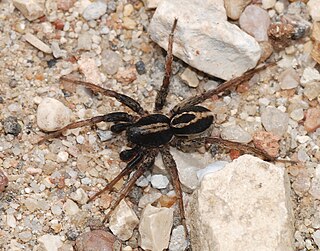
The Goliath birdeater belongs to the tarantula family Theraphosidae. Found in northern South America, it is the largest spider in the world by mass and size, but it is second to the giant huntsman spider by leg span. It is also called the Goliath bird-eating spider; the practice of calling theraphosids "bird-eating" derives from an early 18th-century copper engraving by Maria Sibylla Merian that shows one eating a hummingbird. Despite the spider's name, it only rarely preys on birds.

In anatomy, a process is a projection or outgrowth of tissue from a larger body. For instance, in a vertebra, a process may serve for muscle attachment and leverage, or to fit, with another vertebra. The word is used even at the microanatomic level, where cells can have processes such as cilia or pedicels. Depending on the tissue, processes may also be called by other terms, such as apophysis, tubercle, or protuberance.

Araneus is a genus of common orb-weaving spiders. It includes about 650 species, among which are the European garden spider and the barn spider.

Theraphosa is a genus of tarantula spiders from South America. The three species of the genus stridulate by rubbing setae on their pedipalps and legs.
Palfuria harpago is a spider species of the Zodariidae family.
Capeta is a genus of spiders in the family Salticidae.

Psechridae is a family of araneomorph spiders with about 70 species in two genera. These are among the biggest cribellate spiders with body lengths up to 2 centimetres (0.79 in) and funnel webs more than 1 metre in diameter.

Amaurobius erberi is a species of spider in the family Amaurobiidae, found in Europe and the Canary Islands.
Nigorella is a genus of jumping spiders that was first described by Wanda Wesołowska & Beata Tomasiewicz in 2008. The name is described as "an arbitrary combination of letters", feminine in gender. Three previously species described were transferred to the genus: Pachypoessa albimana as N. albimana, Philaeus manicus as N. manica, and Euophrys plebeja as N. plebeja. Subsequently it was discovered that Euophrys plebeja was a nomen dubium, with no known type specimen.

Theraphosa apophysis is a species of spider in the family Theraphosidae, found in Venezuela.
This glossary describes the terms used in formal descriptions of spiders; where applicable these terms are used in describing other arachnids.

Anoteropsis aerescens is a species of wolf spiders, that is distinguished from all other Anoteropsis species by the shape of the median apophysis of the male bulb and the external sclerites of the female epigyne, especially the wide median septum. It is found in New Zealand.
Inermocoelotes jurinitschi is a funnel-web spider species found in Bulgaria.

Ozyptila trux, the yellow leaflitter crab spider, is a crab spider species with Palearctic distribution.

The two palpal bulbs – also known as palpal organs and genital bulbs – are the copulatory organs of a male spider. They are borne on the last segment of the pedipalps, giving the spider an appearance often described as like wearing boxing gloves. The palpal bulb does not actually produce sperm, being used only to transfer it to the female. Palpal bulbs are only fully developed in adult male spiders and are not completely visible until after the final moult. In the majority of species of spider, the bulbs have complex shapes and are important in identification.

The RTA clade is a clade of araneomorph spiders, united by the possession of a retrolateral tibial apophysis – a backward-facing projection on the tibia of the male pedipalp. The clade contains over 21,000 species, almost half the current total of about 46,000 known species of spider. Most of the members of the clade are wanderers and do not build webs.
Cedicoides is a genus of spiders in the family Cybaeidae made up of four species. It is characterized by well developed tegulum on the bulb of the male pedipalp. When it was published by Charitonov in 1946, it acted as a subgenus to Cedicus. Later, it was argued that the differences between spiders of Cedicoides and those of other subgenera - notably the presence of a terminal apophysis and the shape of the male pedipalp - were great enough to warrant a new genus. In 2003, it was upgraded from subgenus to genus status by Marusik & Guseinov. Spiders of this genus are rare, and are often missing from spider collections taken from these regions during any time other than their mating season.
Neoheterophrictus amboli is a species of theraphosid spiders, which is found in India.
Acutipetala is a genus of funnel web spiders native to the evergreen forests of northern Thailand. It includes only two species: A. donglini and A. octoginta. They are medium-sized spiders, and can be distinguished by the distinctive appearance of several genital structures, including the embolus and the median apophysis of the male pedipalp. Spiders of this genus are 6.7 millimetres (0.26 in) to 8.8 millimetres (0.35 in) long. The eyes are in two rows, both of which are strongly curved forward. The name is a combination of the Latin "acutus", which means "sharp", and the Greek "petalon", which means "leaf" in reference to the sharp, petal shape of the medial apophysis of the male pedipalp.

Ybyrapora is a genus of spiders in the family Theraphosidae (tarantulas), found in Brazil. Its species were formerly placed in the genus Avicularia.
This page is based on this
Wikipedia article Text is available under the
CC BY-SA 4.0 license; additional terms may apply.
Images, videos and audio are available under their respective licenses.











